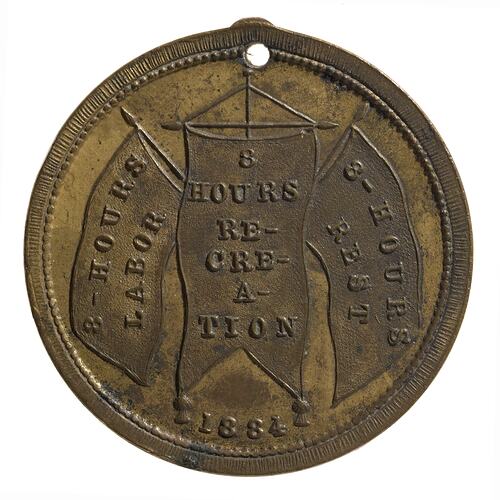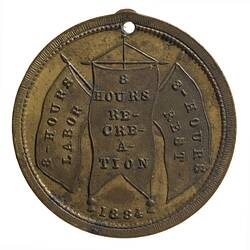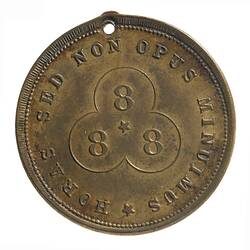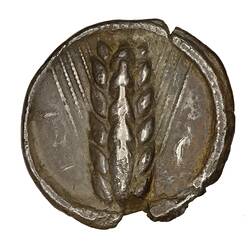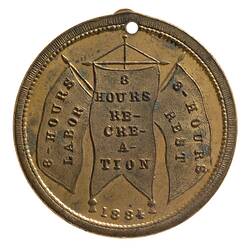Summary
Medal holed for wearing issued to mark the 8 hour movement in 1884.
Action taken by stonemasons on 21 April 1856 led to the establishment of the Eight Hour Day, with the government agreeing that workers employed on public works should enjoy an eight hour day with no loss of pay. It was a world first and became emblematic of the rights of labour. In recognition of the significance of this achievement, April 21 was made a public holiday in 1879 and commemorative marches were held each year from 1879 until 1951. The Eight Hour Day holiday was renamed Labour Day in 1934. In 1955 the Labour Day march and celebrations were replaced by Moomba celebrations.
Obverse Description
Three banners; left reads: 8 hHOURS / LABOUR; middle reads; 8 HOURS / RE- / CRE- / A- / TION; and right reads; 8-HOURS REST
Reverse Description
Small star in centre surrounded by 888 in arms of trefoil; around; * HORAS SED NON OPUS MINIMUS (translated by Carlisle as 'youngest in time but not in achievement'
Edge Description
Plain
Significance
In the 1840s British unions fought unsuccessfully for a ten-hour working day. A decade later, in the summer of 1856, an opportunity for a similar struggle presented itself to tradesmen in Melbourne. A building boom was underway, and labour was scarce. The tradesmen, mostly stonemasons and other skilled building workers, obtained government support for their cause and managed to negotiate an eight-hour working day. The eight-hour day survived economic downturn, employer opposition and union collapse. The principle for building workers to work an eight-hour day without a reduction in their pay soon became widespread, although it took more than half a century to be adopted throughout the workforce. The eight-hour day was widely celebrated as a world first and Australia became known as a 'workingman's paradise'.
In spite of this success, only a minority of workers initially won the eight hour day. Chinese and Aboriginal workers, women and children generally worked much longer hours for less pay.
By the 1880s, thousands of people turned out for the marches that commemorated the winning of the eight-hour day. Trades were represented with elaborate banners, floats and costumes, like the eight-hours armour made by the Tinsmiths Union to symbolise industrial strength and protection. -Reeves, Andrew. 1988. Another Day Another Dollar : Working Lives in Australian History; Museum Victoria web site http://www.museum.vic.gov.au/windows/8hrs/index.asp. -D. Tout-Smith 26/9/2003.
More Information
-
Collection Names
-
Collecting Areas
-
Acquisition Information
Transfer from National Gallery of Victoria (NGV), 15 Mar 1976
-
Date Issued
1884 AD
-
Issued By
-
Mint
-
Series
-
Material
Gilt Bronze
-
Axis
12
-
Classification
-
Category
-
Discipline
-
Type of item
-
Dimensions
22 mm (Outside Diameter), 5.45 g (Weight)
-
Shape
Round with hole
-
References
Car.1884/3
[Book] Reeves, Andrew. 1988. Another Day Another Dollar : Working Lives in Australian History.
-
Keywords
8 Hours Day Celebrations, Trade Unions, 8 Hours Day Movement, Workers, Working Life, Workers Rights, Making History - Eight Hour Day
